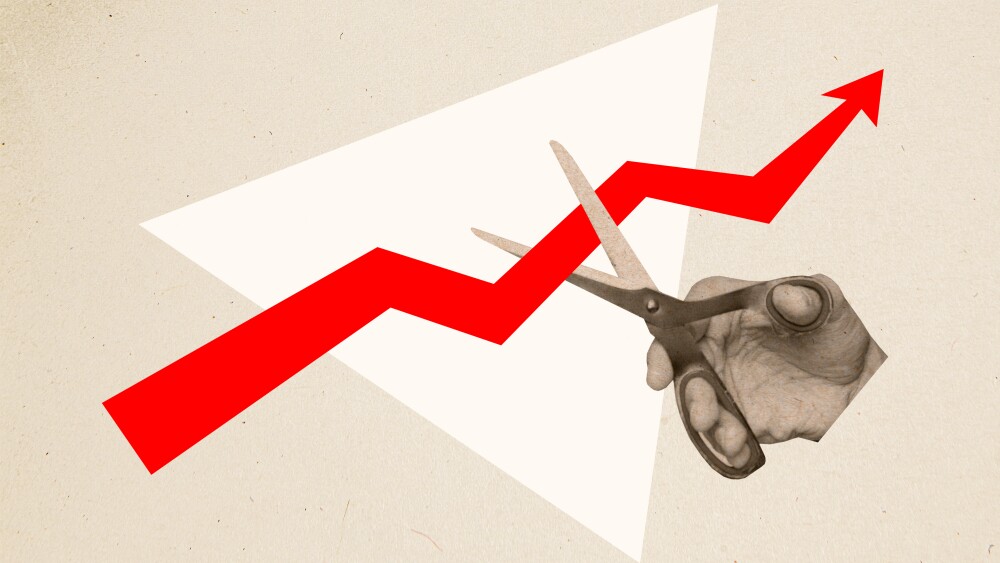Eli Lilly topped the list of the 20 biggest pharmas by market cap with a more than 39% improvement year-to-date in its share price. Other companies have not been so lucky.
The most dramatic positive share moves of the year for the top pharma companies tell compelling stories of blockbuster drug sales, exciting drug approvals and competitor misses. And on the flip side, companies with noticeable dips in share prices faced clinical failures, market pressures and looming patent expirations.
Eli Lilly topped the list of the 20 biggest pharmas by market cap with a more than 39% improvement year-to-date in its share price. It’s no surprise, with blockbuster Zepbound approved for weight loss at the end of 2023. Lilly also seemingly flew just below the radar of Congress, which continues to push for lower drug prices, as rival Novo Nordisk landed right in the crosshairs of Sen. Bernie Sanders.
Looking at companies that haven’t been as successful, Pfizer has fallen over 10% this year amid pressures from an activist investor. Merck, nearing a patent cliff for cancer juggernaut Keytruda, has fallen more than 7%.
Below, we recap the stories behind the share moves for six pharmas this year.
All market cap and share moves are as of Tuesday afternoon at 1:30 p.m. ET. Share price is previous day’s close.
Eli Lilly
YTD Share Change: 37%
Market Cap: $716.2 billion
Share Price: $755
Lilly’s market cap has grown by $162.8 billion since December 31, 2023. With its stock peaking in September at around $960 per share, Lilly can definitely call this year a win.
Shareholders can too. They have received over $1.6 billion in dividends and share repurchases, CEO David Ricks noted on a third-quarter earnings call.
Driving Lilly’s share rally is its obesity portfolio, which began with the November 2023 approval of Zepbound (tirzepatide) by the FDA. As of the end of September, Zepbound was approved in 10 countries with launches in 12 more to come, according to the company. Lilly management told Leerink Partners analysts that China is a near-term priority, with that launch potentially coming in 2025.
Once again, though, Lilly is behind rival Novo Nordisk, which recently launched its obesity therapy Wegovy (semaglutide) in China. Wegovy also enjoyed frontrunner advantage in the U.S. market following Wegovy’s FDA approval in June 2021, though Lilly is gaining ground fast.
Leerink Partners said the sky is the limit for Lilly’s shares. The positive news flow in obesity and diabetes is expected to continue, with further health benefits confirmed as research rolls out. The company also has a robust pipeline of obesity meds, including additional GLP-1 options such as oral orforglipron and another injectable, retatrutide, with Phase III results expected in 2025 and 2026, respectively.
Lilly is also spending cash to bring in more pipeline assets, executing licensing deals in the past year with Fauna Bio and Haya Therapeutics as well as buying out Versanis Bio and Morphic Holding.
And then there’s Alzheimer’s, where Lilly just received approval for disease-modifying treatment Kisunla. The FDA nod puts Lilly up against Biogen and Eisai’s Leqembi.
Pressures to Lilly’s stock include pricing queries, slowing demand and payer constraints, Leerink Partners noted. There’s also a ton of impending competition beyond Novo, such as Amgen’s obesity candidate MariTide, which is moving into Phase III trials following a hotly anticipated readout this week.
Pfizer
YTD Share Change: -10.77%
Market Cap: $145.6 billion
Share Price: $26.17
Pfizer is undergoing a “normalization” of its COVID-19 business, Leerink Partners wrote in a note to clients earlier this month. But is there anything normal about what happened with Pfizer’s COVID franchise?
Perhaps a better way to put it is that the New York pharma is out of the honeymoon phase that occurred after it developed the first approved COVID-19 vaccine, Comirnaty, and followed that up with one of the most widely used therapeutics, Paxlovid. While both are still in use, the franchise has faced significant headwinds as the pandemic waned and vaccination rates dropped.
The company’s shares hit a high of about $60 in December 2021. This year, they have sunk more than 9% to where they currently sit at around $26. The decline has led activist investor Starboard Value to come out of the woodwork to push for change, specifically pointing the finger at CEO Albert Bourla. But that campaign faded just as quickly as it sprung up after Pfizer reported a third quarter earnings beat.
Leerink Partners said that Pfizer has been successful this year in transitioning Paxlovid from a U.S. government market model to the commercial market, where it will rely on disease outbreaks rather than large purchase orders from governments.
Elsewhere, Pfizer has products like Eliquis that are driving revenue; however, that therapy was one of the drugs picked for the first round of Medicare drug price negotiations. But Guggenheim analyst Vamil Divan warned after the earnings release at the end of the October that investors are still worried about the stiff patent cliffs that Pfizer is facing across its portfolio.
Just this week, another competitor hit Pfizer’s portfolio, with BridgeBio receiving an FDA nod for Attruby in transthyretin amyloid cardiomyopathy. Pfizer markets tafamidis as Vyndaqel and Vyndamax in the heart indication, while Alnylam has Amvuttra, currently approved for ATTR amyloidosis and under review by the FDA in ATTR-CM as of this week. Pfizer is also in a tight race with GSK and now Moderna in the repiratory syncytial virus vaccine market.
Earlier in the pipeline, Pfizer is expecting results for an oral obesity candidate called danuglipron early in 2025. This will be a defining moment, as a win could catapult Pfizer back into the big leagues alongside Eli Lilly and Novo Nordisk.
Amgen
YTD Share Change: -5.92%
Market Cap: $145.6 billion
Share Price: $294
Treading around a share decline of about 1.22% last week, Amgen’s stock took a steep turn on Tuesday. Keenly awaited data from the Phase II MariTide study showed weight loss of 20%, on the low end of analyst expectations. The data were comparable to Phase III results for Lilly’s tirzepatide in a similar population.
The news sent the company’s shares down 8% to $270.79 apiece on Tuesday, losing about $23 in value. BMO Capital Markets’ Evan Seigerman had called the pending readout a “make or break” moment for Amgen’s shares. That certainly seems to be the case. At the end of Tuesday, about $7.53 billion in market cap had been wiped out.
Jefferies urged investors to keep calm and carry on, to buy the dip and understand that beating the incumbent therapies was always going to be tough for Amgen. With so much anticipation and competition in this space, a clear beat was unlikely.
“The setup was always going to be challenging: obesity trade has been difficult and other peers have all traded down recently, market has high expectations on ‘differentiation’ and Wall Street always wants higher efficacy,” Jefferies wrote.
The firm expects Amgen’s stock to slowly creep back to normal “as investors digest” the data.
Prior to the readout, BMO’s Seigerman summed up the stakes for MariTide: “Investors have been whipsawed through the MariTide development story throughout 2024. With potentially $60 billion in market cap on the line, the stakes couldn’t be higher...gotta love year-end biotech readouts!”
Vertex
YTD Share Change: 13.35%
Market Cap: $118.6 billion
Share Price: $461
Vertex is the undisputed leader in cystic fibrosis (CF), with products such as Trikafta, Kalydeco, Symdeko and now Casgevy following its late 2023 approval, and it seems that franchise still has room to grow. William Blair’s analysts were pleased to see the company raise guidance after the third quarter.
Vertex will also start to see revenue from the gene therapy Casgevy, which it developed in partnership with CRISPR Therapeutics. Patients have finally begun receiving infusions of the sickle cell disease treatment. The CF franchise is moving from $9 billion yearly revenue toward William Blair’s estimate of $12 billion in peak sales.
In addition, 2025 stands to be a big year for Vertex on the regulatory front, with two FDA decision dates coming up in January, for the CF drug vanzacaftor triple (vanza triple) and oral pain med suzetrigine. That means Vertex could have two launches at the beginning of 2025. The pain therapy is perhaps the most exciting, with so much room in that market for non-addictive and more tolerable options.
Merck
YTD Share Change: -7.46%
Market Cap: $255.5 billion
Share Price: $101
Merck’s story has been defined by Keytruda for years—and rightfully so. The mega-blockbuster has reinvented the cancer space, spidering off into dozens of indications, with a clinical program still churning out data in an attempt to garner even more FDA clearances.
But in recent years, the tenor has changed. Investors have wanted to know what’s next. This year especially has brought news that Keytruda may have finally hit its limit, with failures or trial discontinuations in colorectal cancer, non-small cell lung cancer, cutaneous squamous cell carcinoma and small cell lung cancer.
Merck’s shares have been on the slide since July, when executives revealed a delay in shipments of HPV vaccine Gardasil in China. CFO Caroline Litchfield said the slow down may mean that Merck will ship fewer than its full-year contracted doses by the end of the year. The Chinese market represents about 60–70% of Gardasil’s sales, CEO Robert Davis said on the second quarter call. The vaccine brought in $2.31 billion in the third quarter, down 11% from the year prior as demand continued to decline in China.
BMO Capital Markets analysts see some glimmer of hope in Merck’s pipeline, though, especially a 2023 partnership with ADC expert Daiichi Sankyo (also among this year’s top pharma movers; see chart above). Merck’s Prometheus buyout for a clutch of inflammation and immunology assets and prospects in the cardiovascular portfolio also has a lot of potential, according to the firm.
Earlier this week, Merck announced that a Phase III trial for Winrevair in pulmonary arterial hypertension in a broader population was stopped early because of overwhelming efficacy. The company plans to submit the data to the FDA to expand the drug’s label, which already includes patients with group I PAH. Sales of the drug have already hit $219 million this year, BMO reported.
Novo Nordisk
YTD Share Change: 2.76%
Market Cap: $475.5 billion
Share Price: $104
Novo’s market cap has risen substantially over the past couple of years following its Wegovy approval. It hit a high of $642.9 billion in June of this year, with all of 2024 resembling a rolling hill, not unlike some found in the rural countryside of its Danish homeland. In June, Novo’s shares peaked at about $127 apiece, but have since fallen back to near the $106 where they started the year.
Its ups and downs over the past year track with the news flow surrounding the GLP-1 space. Novo bumped up on Tuesday with a two-pronged hit of positive news: the Biden administration proposed covering weight loss drugs for patients on Medicare and Medicaid and Amgen’s MariTide weight loss data ended up on the low end of expectations.
This pharma, which is literally remaking its country’s fortunes, will be a headline story for years to come.






